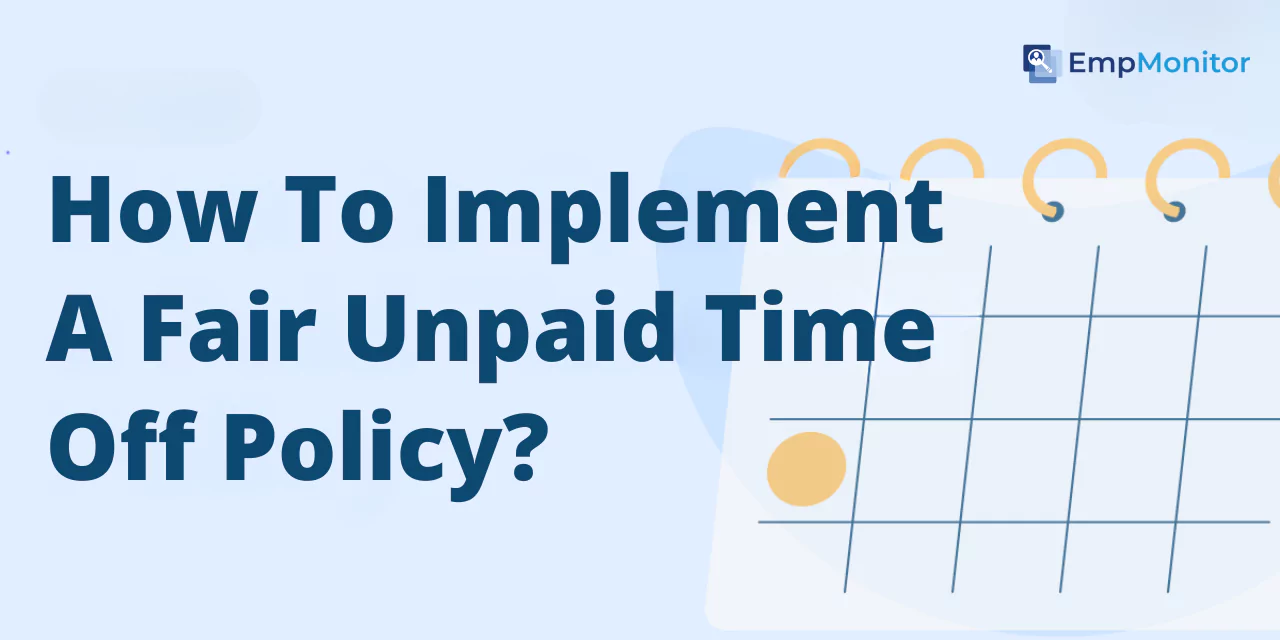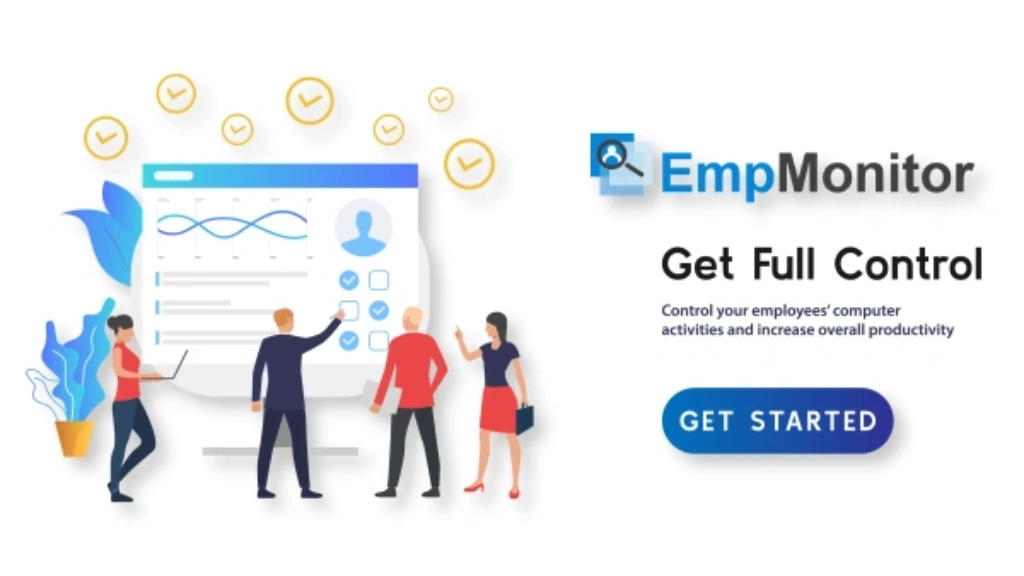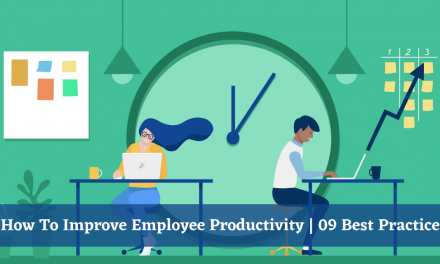Offering unpaid time off in today’s competitive work environment can be a strategic way to balance employee satisfaction and productivity. While it may seem counterintuitive to allow employees to take time away without pay, a well-crafted Unpaid Leave policy can provide significant benefits for both employees and employers.
In an era where work-life balance is increasingly important, providing Unpaid Leave gives employees the flexibility to manage personal commitments, pursue passions, or address unforeseen circumstances. This flexibility enhances their overall well-being and fosters a sense of loyalty and trust within the organization. Employees who feel supported are likely to be engaged and productive at work.
For employers, the benefits extend beyond just enhanced employee morale. By offering unpaid Leave, companies can reduce turnover rates, which will lower the costs associated with recruiting and training new employees. Additionally, it allows businesses to accommodate diverse employee needs without significantly impacting the bottom line.
A thoughtfully designed unpaid time off policy can help employers navigate periods of low demand or economic uncertainty by providing a buffer that maintains workforce flexibility. It can also be a competitive advantage in attracting top talent who value workplace flexibility and support.
Implementing a fair and transparent unpaid Leave policy requires careful planning and communication. In the following sections, we will explore the steps to create and implement an effective policy that benefits both employees and the organization.
In a hurry? Listen to the blog instead!
What Is Unpaid Time Off?

Unpaid time off can be crucial for maintaining a healthy work-life balance. Employees may need to take time off for reasons that fall outside the scope of their paid leave entitlements. Whether dealing with a family emergency, taking care of personal health issues, or simply needing a mental health day, unpaid Leave provides the necessary flexibility to address these situations.
Benefits Of Unpaid Time Off
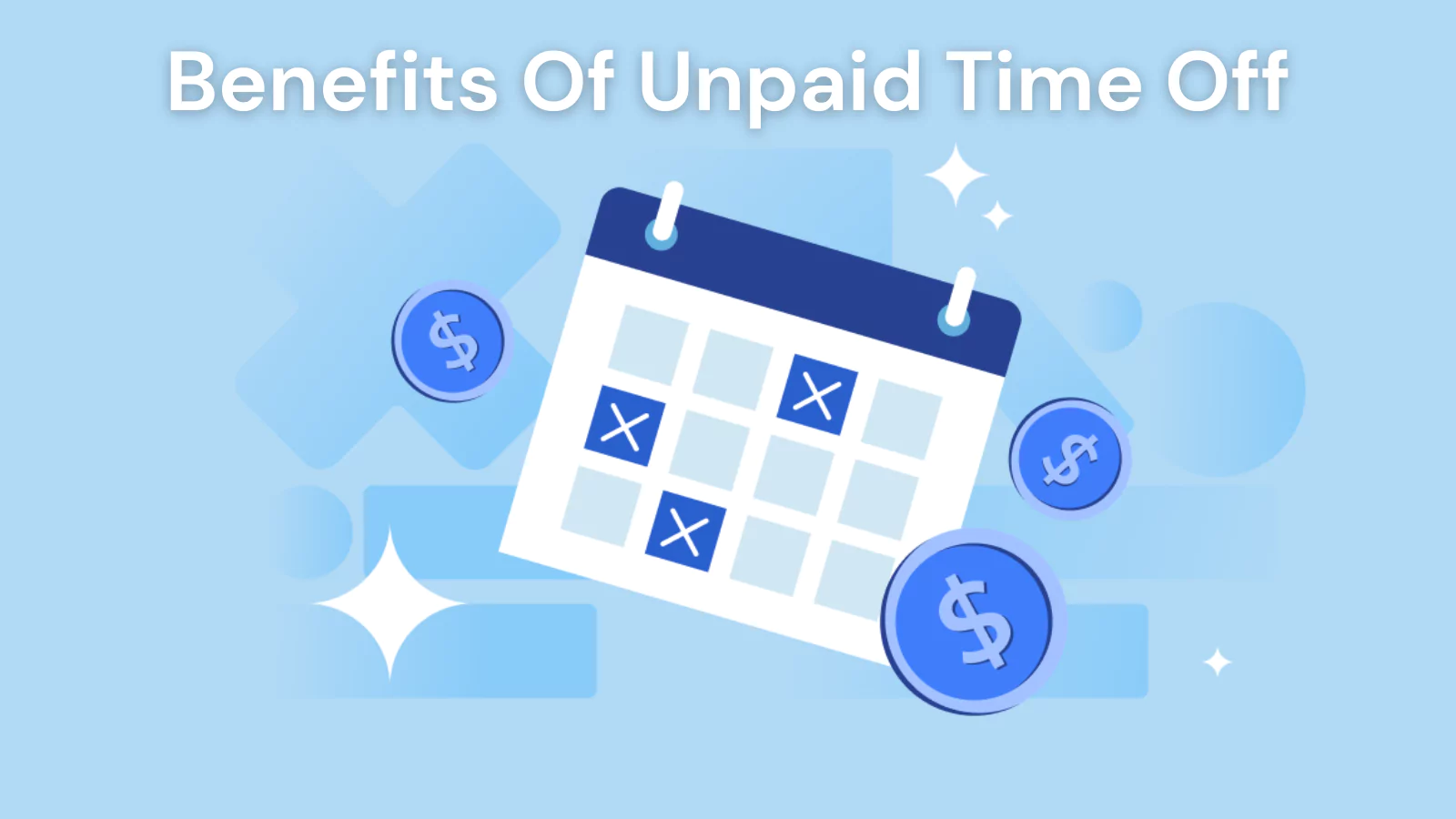
For Employees
- Flexibility: Helps employees handle personal matters without using paid leave. They can address family emergencies, and personal health issues, or take a mental health day without worrying about financial implications. This freedom to manage personal situations without financial strain can be a crucial factor in maintaining overall well-being.
- Work-Life Balance: Encourages a healthier balance between work and personal life. Employees can take time off for important life events, travel, or simply recharge, which can lead to improved mental health and overall well-being. When employees have the opportunity to manage their personal lives effectively, they are more likely to be engaged and committed when they return to work.
- Job Security: Employees can take necessary time off without fear of losing their jobs. Knowing a position is secure even when they need to take unpaid leave fosters a sense of trust and loyalty towards the organization. This assurance can reduce stress and anxiety, contributing to a more positive work environment.
For Employers
- Enhanced Morale: Employees feel valued and respected. When they have the flexibility to manage their personal lives without financial strain, it leads to higher job satisfaction and a more positive work atmosphere. A supportive work culture can enhance employee morale, leading to a more motivated and productive workforce.
- Retention: Flexible policies can reduce turnover. Employees who feel supported by their employer are more likely to stay with the company long-term, reducing recruitment and training costs associated with high turnover rates. A stable workforce allows the company to maintain continuity and build on the accumulated knowledge and experience of its employees.
- Productivity: Satisfied employees are more engaged and productive. When employees return from unpaid time off feeling refreshed and balanced, they are often more motivated and focused. This boost in productivity can have a positive impact on the overall performance and efficiency of the organization.
Unpaid Leave policies are not just about granting leave without pay; they reflect an organization’s commitment to its employees’ well-being. By offering such flexibility, companies can build a resilient and dedicated workforce that thrives personally and professionally. Embracing unpaid time off as a strategic approach can lead to a more harmonious and productive work environment.
Steps To Implement A Fair Unpaid Time Off Policy
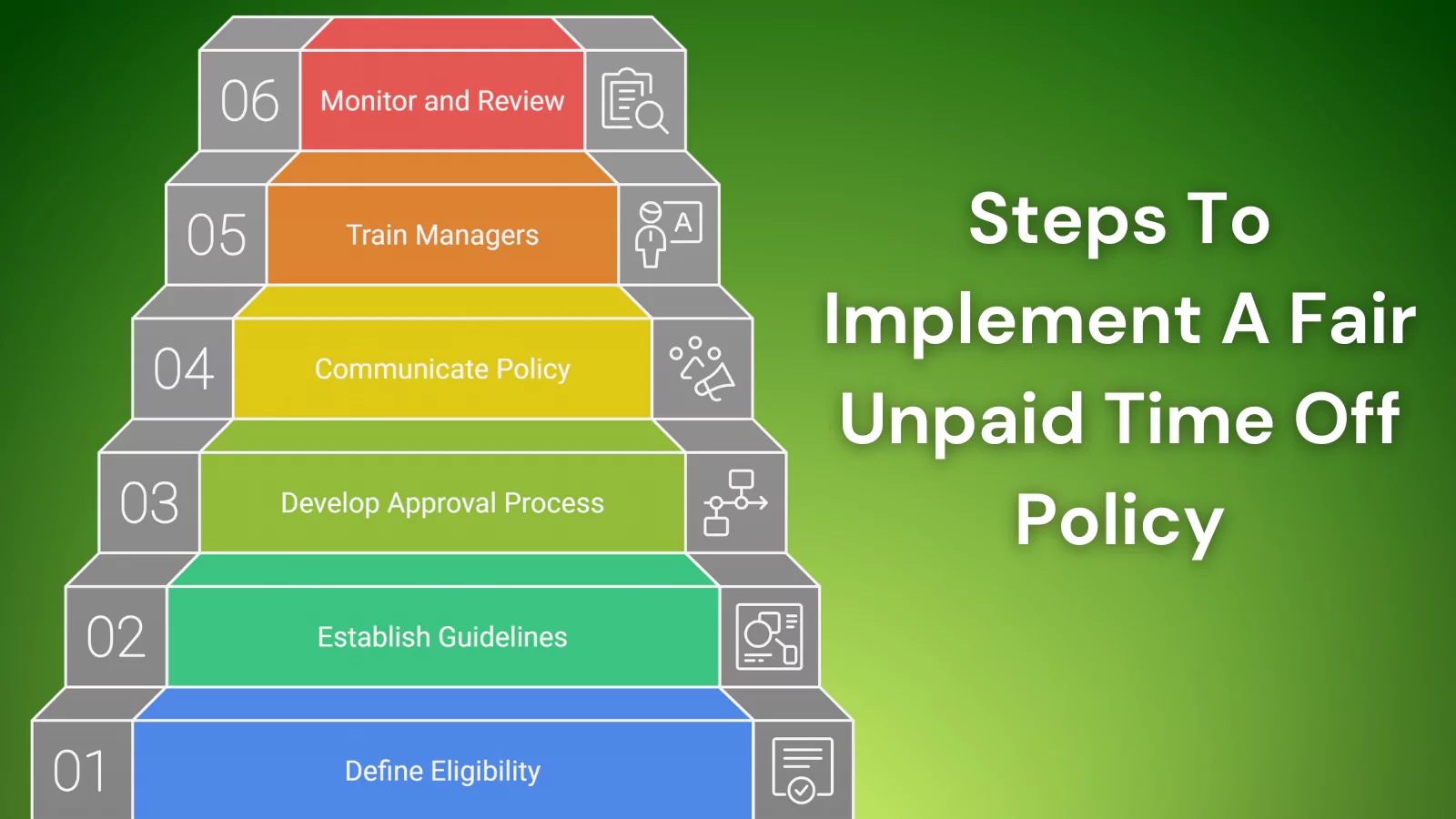
1. Define Eligibility Criteria
Start by specifying which employees qualify for unpaid Leave. It could be based on tenure, employment status, or departmental needs. Ensure that the criteria are clear and transparent to avoid misunderstandings.
2. Establish Clear Guidelines
Create detailed guidelines that outline the policy:
- Duration Limits: Define the maximum number of unpaid days employees can take within a period.
- Frequency Limits: Specify how often employees can request unpaid Leave in a year.
- Notice Requirements: Detail how far in advance employees should request time off.
3. Develop an Approval Process
An effective time off request policy example is essential for consistency and fairness. The approval process should include:
- Submission Methods: Outline how employees should submit requests (e.g., email, form, HR software).
- Approval Criteria: Explain the factors considered when approving requests.
- Managerial Approval: Specify who must approve the requests and the steps in the decision-making process.
4. Communicate the Policy
Ensure all employees are aware of the policy through:
- Onboarding Sessions: Introduce the policy to new hires during onboarding.
- Employee Handbooks: Include the policy in the company handbook for easy reference.
- Internal Communications: Use emails, meetings, and intranet posts to inform current employees about the policy.
5. Train Managers
Managers play a critical role in implementing the policy fairly. Provide training on:
- Policy Details: Ensure managers understand the policy thoroughly and can explain it to their team members.
- Fair Implementation: Teach managers how to apply the policy consistently and equitably.
- Employee Support: Equip managers with skills to support employees who need time off and address any concerns.
6. Monitor and Review
Regularly review the policy to ensure it meets the needs of employees and the organization. Consider:
- Employee Feedback: Gather feedback from employees about the policy’s effectiveness and any areas for improvement.
- Policy Adjustments: Make necessary adjustments based on feedback and changing organizational needs.
- Compliance: Ensure the policy complies with labor laws and regulations to avoid legal issues.
Using tools such as EmpMonitor for seamless time tracking and leave management, organizations can ensure their unpaid leave policy is fair and effective.
EmpMonitor’s Role In Leave Management
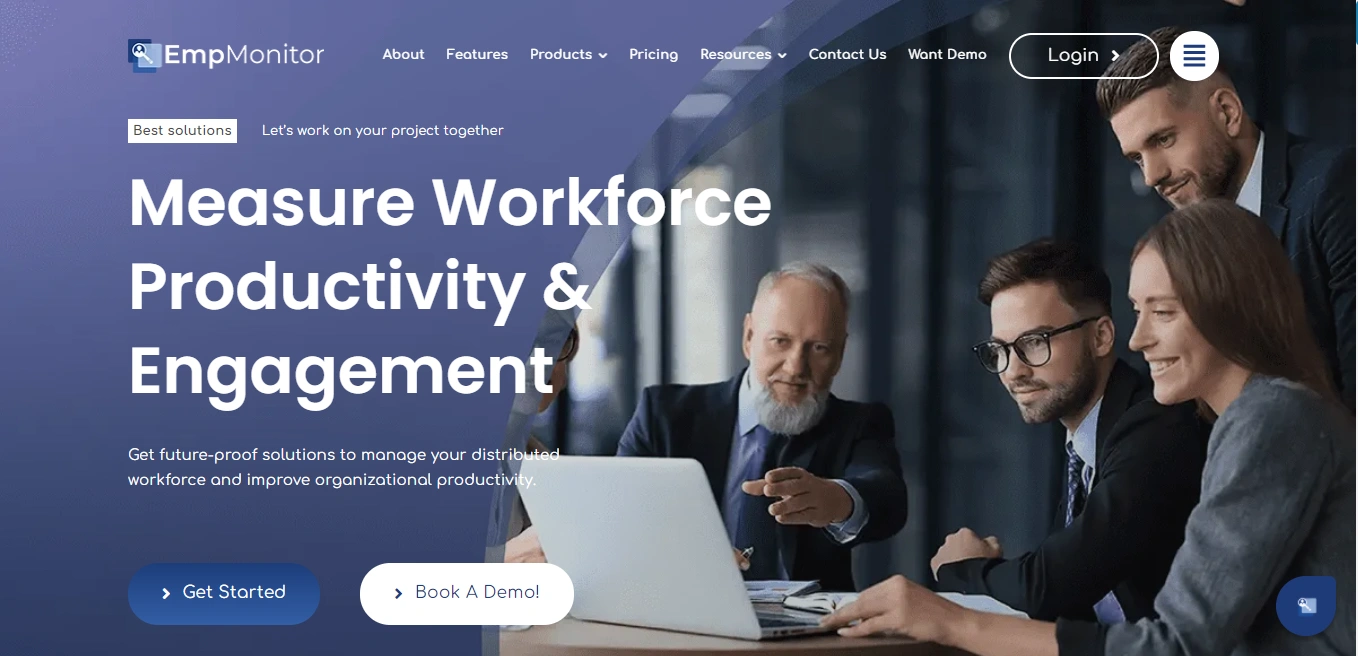
Key Features of EmpMonitor
- Advanced Time Tracking: Keep accurate records of employee hours, including unpaid Leave.
- Leave Management: Simplify the process of approving and tracking leave requests.
- Productivity Analysis: Monitor employee productivity and identify areas for improvement.
- User-Friendly Interface: Easy for both managers and employees to use.
Benefits of Using EmpMonitor
- Streamlined Requests: Employees can submit time off requests directly through the platform.
- Efficient Approvals: Managers can quickly approve or decline requests, ensuring clear communication.
- Accurate Tracking: Maintain detailed records of all time off, aiding in scheduling and compliance.
- Enhanced Productivity: With a clear understanding of who is available and when resources can be allocated efficiently.
By following these steps and leveraging tools like EmpMonitor for seamless time tracking and leave management, organizations can ensure their unpaid Leave policy is both fair and effective.
Tips For Successfully Managing Unpaid Time Off

Encourage Open Communication
- Transparent Conversations: Encourage employees to discuss their unpaid Leave needs with their managers. It fosters trust and ensures that both parties are on the same page.
- Regular Check-Ins: Implement regular check-ins between managers and employees to address any concerns or questions related to unpaid leave.
Maintain Fairness and Consistency
- Equal Treatment: Ensure that all employees are treated equally when it comes to approving unpaid leave. Avoid favoritism to maintain a fair and harmonious work environment.
- Consistent Application: Apply the unpaid time off policy consistently across the organization to prevent misunderstandings and grievances.
Monitor Impact on Productivity
- Track Metrics: Use time tracking software to monitor the impact of unpaid leave on productivity. It helps identify any potential issues and areas for improvement.
- Adjust Workloads: Adjust workloads and redistribute tasks as needed to ensure that the absence of an employee does not negatively affect the team’s performance.
Provide Support and Resources
- Employee Assistance Programs: Offer resources such as employee assistance programs (EAPs) to support employees during their unpaid time off.
- Flexible Scheduling: Consider flexible scheduling options to accommodate employee needs and maintain productivity.
Review and Update the Policy
- Regular Reviews: The unpaid leave policy to ensure it remains relevant and effective. Gather feedback from employees and managers to make necessary adjustments.
- Stay Informed: Stay informed about changes in labor laws and regulations that may impact your unpaid time off policy.
By following these tips and leveraging tools like EmpMonitor for seamless employee time off tracking, organizations can ensure that their unpaid leave policy is both fair and effective.
Read More
Time Off Request- Meaning, What To Include In Policy, & More!
Time Off Management: The Ultimate Guide
The Legal Aspects Of Unpaid Time Off Policies

What Are Employment Laws?
Different countries and regions have varying laws governing unpaid leave. It’s crucial to understand the specific regulations applicable in your jurisdiction. This includes understanding employees’ rights and the obligations of employers.
Documentation And Record Keeping
Maintaining accurate records of unpaid leave is vital for legal compliance. This includes keeping track of:
- Employee Requests: Document all unpaid leave requests and approvals.
- Duration and Frequency: Record the duration and frequency of unpaid time off taken by each employee.
- Communication: Keep records of communications related to unpaid leave, such as emails or forms.
Non-Discrimination Policies
Ensure the unpaid time off policy is applied consistently and fairly to all employees. Avoid discrimination based on race, gender, age, religion, or other protected characteristics. Consistent application helps prevent legal disputes and promotes a fair work environment.
Compliance With Employment Contracts
Review employment contracts to ensure that the unpaid leave policy aligns with the terms and conditions agreed upon. This includes:
- Contract Clauses: Ensure that any clauses related to unpaid leave are clear and legally compliant.
- Employee Agreements: Obtain written agreements from employees acknowledging their understanding of the unpaid leave policy.
Staying Updated
Labor laws and regulations can change over time. It’s essential to stay updated with any legal changes that may impact your unpaid leave policy. Regularly review and update the policy to ensure ongoing compliance.
Seeking Legal Advice
Consult with legal professionals or employment law experts to ensure the unpaid leave policy complies with all relevant laws and regulations. They can provide guidance on best practices and help you navigate any legal complexities.
By understanding and addressing the legal aspects of unpaid leave policies, organizations can ensure compliance and create a fair and supportive work environment.
Conclusion
A fair and effective unpaid time off policy can significantly enhance employee satisfaction and productivity. By offering flexibility through unpaid leave, organizations show their commitment to the well-being of their workforce. This not only boosts employee morale but also fosters a loyal and dedicated team.
EmpMonitor is more than just a time-tracking tool; it is a comprehensive solution designed to streamline employee monitoring and leave management. By leveraging EmpMonitor’s advanced features, organizations can ensure that their unpaid leave policies are fair and effective, ultimately creating a supportive and productive workplace.
FAQ
1. How can I request unpaid time off?
You can request uncompensated leave by following your company’s leave request process. This usually involves submitting a leave request form or sending an email to your manager or HR department. Be sure to specify the type and duration of leave you need.
2. How does my company track non-paid leave?
Companies typically track non-paid leave through their HR systems or time tracking software. These tools help maintain accurate records of all leave requests and approvals, ensuring transparency and easy access to leave records for both employees and managers.
3. Can I take leave without pay if I’ve exhausted my paid leave?
Yes, most organizations allow employees to take leave without pay after exhausting their paid leave. Check your company’s specific policy on leave without pay to understand the guidelines and approval process.
4. How does non-salaried leave impact my benefits?
Non-salaried leave typically does not count towards paid time off benefits like vacation or sick leave. However, your benefits such as health insurance and retirement plans may continue, depending on your company’s policy. It’s best to review your organization’s leave policy or consult HR for specifics.
5. What is the difference between unpaid time off and paid leave?
Unpaid absence is leave taken without receiving compensation, while paid leave is time off that is compensated by the employer. Paid leave usually includes benefits such as vacation, sick leave, and personal days. Unpaid absence provides flexibility but does not include financial compensation.

